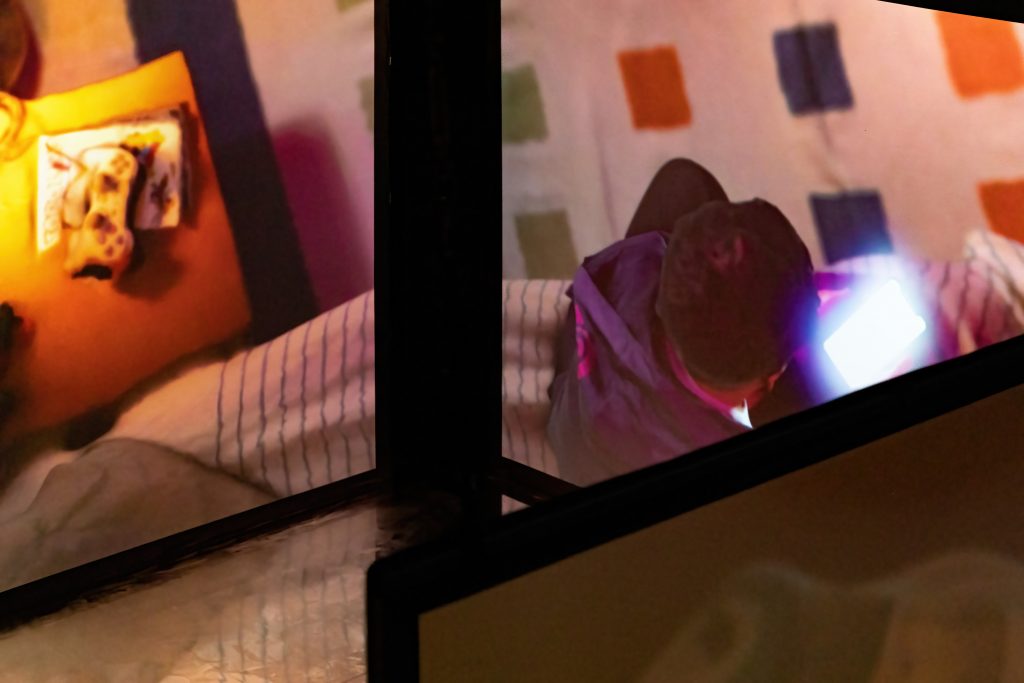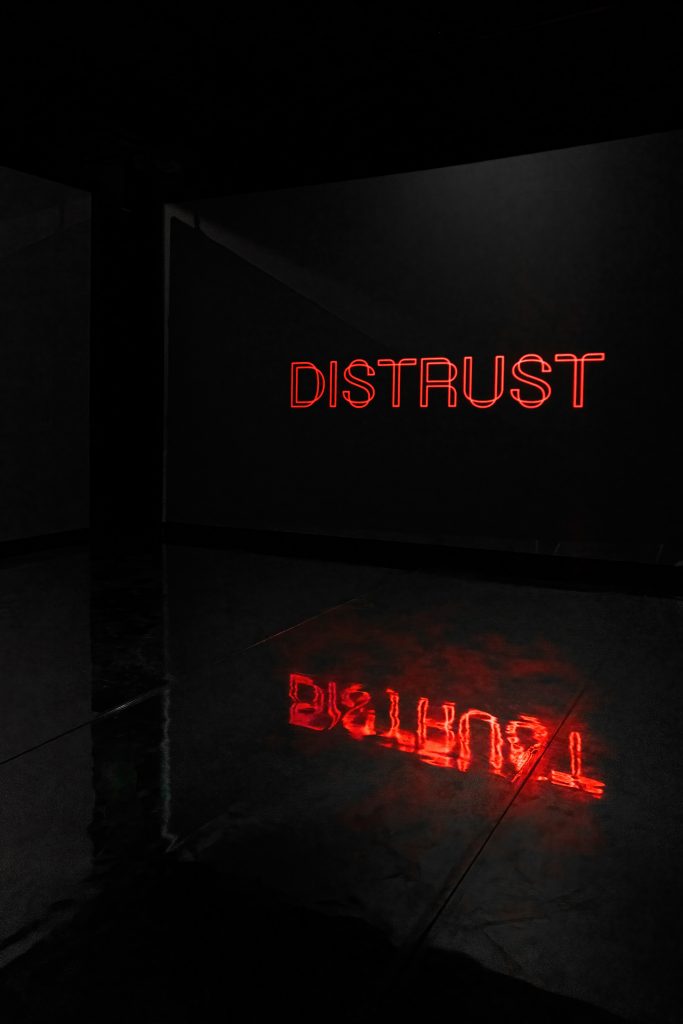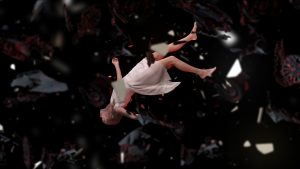Elevate Festival ran from August 4 to 8, 2021, in Graz, Austria, which included an exhibition by LOREM entitled Distrust Everything. Today, the Italian artist shares an exclusive video and interview with the Festival’s curator, Berit Gilma, on the exhibition and their involvement in artificial intelligence technology.
In Distrust Everything, LOREM intervenes the milieu of social and technological factors surrounding dreams and contemporary psychedelia. Using machine-learning technology and 3D, the artist renders vaguely familiar characters and icons into a surreal narrative, alluding to the power of perception in shaping the human experience. The adapted video, released today via AQNB, explores the political underpinnings of the piece, particularly US military involvement in the psychonaut movement during the 70s. LOREM spoke with Gilma during the Festival to further clarify these ideas.
Berit Gilma: I would like to speak more about the process. You used a specific dataset to train AI for your installation, which was based on dream reports by Mirek Hardiker. Hardiker is a former Stanford researcher and he’s also a psychonaut, which is a concept I really like. A psychonaut is similar to an astronaut but instead of exploring the universe he is exploring the depth of psyche and unconsciousness. Hardiker was reporting his dreams on a daily basis for 21 years, resulting in a dream dataset. How did you engage with his work?

Lorem: Meeting with Mirek was such an eye-opening encounter and was only a couple of years ago. He is a very strange, but brilliant Polish American artist from the Bay Area. As you had mentioned, he had started working as a researcher at Stanford during the ‘70s and was a member of a very weird US Defense funded research unit. The military invested a budget to investigate some of the technologies which Russia was testing at the same time. The Russians were investing mediumship and remote viewing and sensing, all while triggering Americans’ fear of missing out. No one in the American university was deeply tied to the project, and following one year of mediocre tests and such, the research unit was finally dismantled. However, in the meantime, Mirek had developed a very interesting approach to ‘dream report transcription’, which was both fast and effective. He began first transcribing his own dreams, revolving his interest towards his own persona and speculation on the unconscious. He kept recording dreams on a daily basis for the next 21 years. When I met him and he mentioned the project, I immediately had the idea to use them as a dataset, mostly because it was a large body of text, and very useful to train neural networks.
BG: AI basically generated the whole plot and narrative, and was involved in the development of characters, actions, and dialogues.
L: Yes. The first step was to find common topics and characters between the corpus of dreams. So, with this in mind, we built a human-labelled dataset, and we catalogued all the characters in the dreams, reconnecting them around Jung’s archetypes. That was the very foundational moment for the work of Episode 1. We “distilled” three main characters: the Innocent, the Lover and the Rebel. We then started generating proper plots (with GPT-2/3 but also with RNN), producing all the actions and interactions between characters. Lastly, we wrote dialogues via literature-based text generation (with GPT-2 and GPT-3 neural networks).

BG: Let’s talk a little bit about the visual aspect of the work. Some of the images are AI generated, but you also used 3D photogrammetries. You were collaborating with other artists as well. Could you explain how the AI generated the images and how it was also involved in creating the audio for the piece?
L: Most of the images, in this case, were not actually AI-generated. There’s a little part in the installation which is totally AI-generated, but in the end, I wanted to recreate more realistic images, or at least more realistic subjects within them. I chose to involve Karol Sudolski, who is more or less a part of LOREM, as we often collaborate… he is really important for its development as a whole. He co-directed the visual aspect of this episode, and he built the photogrammetries we placed in the film. As an overall point, collaborations are an essential part of my work. LOREM is a very personal project, but at the same time it acts collectively, in a way in which my vision is totally conjoined with perspectives from others. That’s why I mostly tend to avoid exposing my own image and my persona with LOREM.
BG: How long has LOREM already existed in that way?
L: I started working with AI in 2016. At that moment, I had a very precise idea of the project, but the name had not yet come to mind.
BG: Tell us about the role of music in this installation. And of the importance of it within the concept of immersion.
L: I would say I am not really that interested in building any interplay between myself and an audience. I am, however, fascinated by the idea of imposing my vision on or to people, even to overwhelm them. A VR immersive experience forces people to quite literally see through another set of eyes. This is also related to the topic of Distrust Everything in general. Evidently, music plays a crucial role in this too, as it becomes, I think, the driving element of the work. For the music, once again, it was an individualistic process. I involved Acre, an artist based in Manchester who I have followed for a few years now, and we produced the soundtrack of the last scene together. I also made a track with Kid Brothers, and a remix of a song by Hampar Soum.

BG: There’s a last important element we didn’t talk about. There is voice in the installation. It sounds like a child’s voice, and it is leading us through the plot. Where does the voice come from?
L: We had the chance to record the voice of Ilyas – a young boy from Belgium who’s amazingly talented in interpreting text. He not only recorded his voice from the plot. We also employed his voice to train a small text-to-speech tool. At times, the voice sounds really synthetic and uncanny, and the fact he’s a child further enhances some of the more peculiar elements within the installation.
BG: My last question is about the title: Distrust Everything. Why?
L: Well, it’s not exactly easy to provide a brief explanation, but let’s say Distrust Everything is an invitation to retool our relationship with the external world, that which we often perceive as something of a ‘given’ thing, as a datum. The boundary between dreams and reality is often blurred, which I think feels especially true in today’s world, and certainly in the so-called “post truth” society. We literally inhabit narrations and exist in a time where feelings and impressions seem to be more relevant than facts. Perhaps I can provide a little provocation here, in addition to that: I think the idea of truth, particularly the way in which we understand it in 2021 and simply as we feel it nowadays, it somehow has become an overrated tenet of reality. This is something rather evident in more recent examples of right-wing and populist movements, as there is an understanding that emotions indeed affect reality more often than truth. Perhaps then, we should rethink this rather normative or stable idea of truth which we have and consider abandoning the idea that the world we believe we live in is mirrored by reality. We could possibly then try to build new narrations and imagery, that which could help us truly heal instead of simply “understanding”. You could say, that is more or less what Distrust Everything is about.**
LOREM’s Distrust Everything ran at Elevate Festival in Graz from August 4 to 8, 2021.














